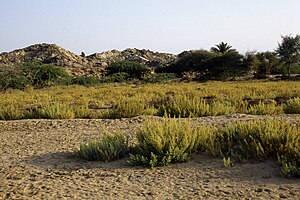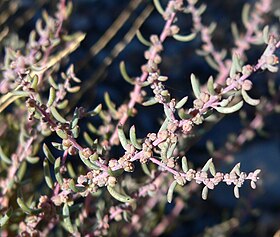|
تضامنًا مع حق الشعب الفلسطيني |
سويداوات
أسرة السويداوات | |
|---|---|
| التصنيف العلمي | |
| النطاق: | حقيقيات النوى |
| المملكة: | نباتات |
| الفرقة العليا: | نباتات جنينية |
| القسم: | نباتات وعائية |
| الشعبة: | حقيقيات الأوراق |
| الشعيبة: | بذريات |
| العمارة: | كاسيات البذور |
| الطائفة: | ثنائيات الفلقة |
| الطويئفة: | قرنفلانيات |
| الرتبة العليا: | قرنفلاوايات |
| الرتبة: | قرنفليات |
| الفصيلة: | قطيفية |
| الأسرة: | سويداوات |
| الاسم العلمي | |
| Suaedoideae Ulbr. |
|
| تعديل مصدري - تعديل | |
السويداوات (الاسم العلمي:Suaedoideae) هي أسرة من النباتات تتبع فصيلة القطيفية من الرتبة القرنفليات.
الوصف
تمتلك السويداوات أوراق متطورة. باستثناء جنس الطحماء (الاسم العلمي:Bienertia)، والأوراق تظهر كحزم وعائية مركزية وجانبية كثيرة. الأوراق ليست متجه للأسفل ولا ملتفة الساق.
والنورات ذات إزهرار سنمي إبطي. الزهور تستند إلى آباط من القنابات، مع قنيبات جانبية. يتكون غلاف الزهرة من 5 تيبالات tepals، والتي هي نوعاً ما ملتحمة عند الأصل.لها خمسة أُسدية. البذور يرفق الجنين دوامة، ومعظمهم من دون أي بذراء محيطية perisperm.
التوزيع
ونباتات السويداوات لها تنتشر في جميع أنحاء العالم تقريبا. وتعتبر هذا النباتات هامةً للغطاء النباتي على الشواطئ والموائل الداخلية المالحة. وهي شائعة خصوصا في الأراضي الجافة (القاحلة).
Photosynthesis pathway
Among the species of Suaedoideae, there are nearly equal numbers of C3-plants and C4-plants. During the evolution of the subfamily, the C4-photosynthesis pathway seems to have been derived from four independent origins: two times with Kranz C4 anatomy in Suaeda section Salsina and Suaeda section Schoberia. Two independent origins of non-Kranz C4 systems are found in Bienertia and Suaeda section Borszczowia. In these plants, the photosynthesis pathways are located without spatial separation in a "single cell C4" type.[1]
التصنيف


وفقاً لبحث النشوء والتطور من قبل كابرالوف وزملاؤه (Kapralov et al. 2006), فإن السويداوات تنقسم إلى قبيلتين نباتيتين هما:
- قبيلة الطحماوية وتضم جنساً وحيداً:
- الطحماء وله ثلاثة أنواع:
- طحماء دائرية الأجنحة Bunge ex Boiss.[2]
- طحماء الخليج العربي Akhani[3]
- Bienertia kavirense Akhani [4]
- الطحماء وله ثلاثة أنواع:
- قبيلة السويداوية وتضم جنساً وحيداً:
انظر أيضاً
مراجع
- Maxim V. Kapralov, Hossein Akhani, Elena V. Voznesenskaya, Gerald Edwards, Vincent Franceschi, Eric H. Roalson (2006): Phylogenetic Relationships in the Salicornioideae / Suaedoideae / Salsoloideae s.l. (Chenopodiaceae) Clade and a Clarification of the Phylogenetic Position of Bienertia and Alexandra Using Multiple DNA Sequence Datasets. Systematic Botany volume 31(3), p. 571–585. pdf-file (chapters description, distribution, systematics)
- ^ Gudrun Kadereit, Thomas Borsch, K. Weising, und Helmut Freitag (2003): Phylogeny of Amaranthaceae and Chenopodiaceae and the evolution of C4 photosynthesis. - Int. J. Plant Sci. 164(6), p 959–986.
- ^ Akhani H, Ghobadnejhad M, Hashemi SMH (2003) Ecology, biogeography and pollen morphology of Bienertia cycloptera Bunge ex Boiss. (Chenopodiaceae), an Enigmatic C-4 plant without Kranz anatomy. Plant Biology 5(2):167-178. "نسخة مؤرشفة" (PDF). مؤرشف من الأصل في 2012-04-02. اطلع عليه بتاريخ 2014-02-21.
{{استشهاد ويب}}: صيانة الاستشهاد: BOT: original URL status unknown (link) - ^ Akhani H, Barroca J, Koteeva N, Voznesenskaya E, Franceschi V, Edwards G, Ghaffari SM, Ziegler H (2005) Bienertia sinuspersici (Chenopodiaceae): A new species from southwest Asia and discovery of a third terrestrial C4 plant without Kranz anatomy. Systematic Botany 30(2):290-301.
- ^ Akhani, H, Chatrenoor T, Dehghani M, Khoshravesh, R, Mahdavi, P. and Z. Matinzadeh. 2012. A new species of Bienertia (Chenopodiaceae) from Iranian salt deserts: a third species of the genus and discovery of a fourth terrestrial C4 plant without Kranz anatomy. Plant Biosystems 146: 550-559. DOI:10.1080/11263504.2012.662921.
- ^ أ ب ت P. Schütze, Helmut Freitag & K. Weising (2003): An integrated molecular and morphological study of the subfamily Suaedoideae Ulbr. (Chenopodiaceae), In: Plant Systematics and Evolution, Volume 239, p. 257-286: Abstract. نسخة محفوظة 27 يونيو 2019 على موقع واي باك مشين.
| سويداوات في المشاريع الشقيقة: | |

